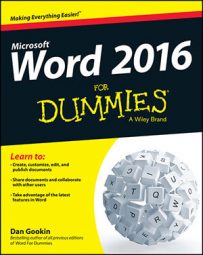You are likely to be spending lots of time with Word 2016. So, why not use all the tricks of the trade? Here are ten items of friendly, helpful word-processing advice.
Keep printer paper, toner, and supplies handy
The electronic office is a myth. Along with your word processor, you need some real-world office supplies. Keep them stocked. Keep them handy.
When you buy paper, buy a box. When you buy a toner cartridge or printer ribbon, buy a second. Keep a good stock of pens, paper, staples, paper clips, and all other office supplies handy.
Get some references
Word comes with plenty of help, given its built-in spell checker and thesaurus. The Smart Lookup command (on the Review tab) also helps with references. Still, nothing beats a real-world dictionary — even if it’s an electronic one.
For all writers suffering through the English language, you may want to consider getting a copy of Strunk and White’s The Elements of Style (Longman). The book is worth the cost simply for its reference on where to place apostrophes and commas.
Among some great references are books containing common quotations, slang terms and euphemisms, common foreign words and phrases, and similar titles. These real-world books beat the pants off of any digital reference.
Keep your files organized
Use well-named, organized folders to store your Word document files. Keep related documents together in the same folder. Properly name document files so that you know what’s in them.
Add the junk later
Write first, then format, then edit. Keep writing and editing. Save your stuff. Only when you truly finish writing should you go back to insert a picture or a graphical doodad. Doing these tasks last keeps you focused on writing, which is the main part of your document. Also, Word behaves better when a document doesn’t have a lot of graphics or fancy junk in it. Write first, add the junk later.
Back up your work
You should have two copies of everything you write, especially the stuff you value and treasure. Keep the original copy on the computer’s main storage device. A second copy, or backup, should also be made, one that doesn’t live in the same location as the original.
Cloud storage is its own form of backup. That’s because the original stays on the computer’s local storage system and the cloud copy is available on the Internet, from any device that has Internet access.
All PC backup programs keep a spare copy of your files on external storage devices. If you don’t have a backup program, get one! Windows comes with a backup program, or you can use the File History feature. Either one is a great way to keep additional copies of your documents — just in case.
Understand tabs
To best use tabs in Word, you must accept that they consist of two items. First is the tab character. You press the Tab key to insert a tab character. Second is the tab stop, which sets the tab key’s size and the behavior of text after you press the Tab key.
Any time you feel the slightest urge to press the spacebar more than once, you need to reconsider what you’re doing and use a tab and a tab stop instead.
Use those keyboard shortcuts
The keyboard is faster than the mouse. For common activities, such as Save, use the keyboard shortcut instead, Ctrl+S in this instance. Just about every Word command sports a keyboard shortcut. For those that don’t, you can use accelerator keys on the Ribbon.
Yes, memorizing keyboard shortcuts is a pain. The key to success is to use the shortcuts. Use them often enough, and you’ll remember them.
Try new things
In Word, as in life, people form habits and repeat behaviors. Rather than falling into this trap, consider trying new behaviors from time to time.
For example, consider using tables rather than tabs to organize your stuff. If you’re an ancient Word user from days gone by, check out some Quick Styles or mess around with themes. Try to explore as much of Word as possible. You may master a new trick or discover a faster way to get something done.
Let Word do the work
Word does amazing things. In fact, any time you feel that you’re doing too much work in Word, an easier, faster way to get the same job done is probably available.
Examples of this suggestion include page numbering and setting a page break. Word happily adds page numbers for you, keeping track of them automatically. A page break always forces text to start at the top of the page, no matter how much you edit text before that point.
Don’t overreact to problems
The computer can be a frustrating tool, especially when it crashes or randomly misbehaves. It’s easy to panic when something goes wrong.
When Word does screw up, relax. The document recovery feature will help you restore anything you’ve typed after saving. (Although do save often.) If you back up your files, you can get those restored as well.
For heaven’s sake: Do not reinstall Word to fix a problem! A lot of Word’s foibles can be adjusted by changing settings or running the Office Repair utility. Even when those efforts fail, experts are available to help you figure out what when wrong. You may not get help as rapidly as you want, but things will get fixed soon.
Don’t take it all so seriously!

